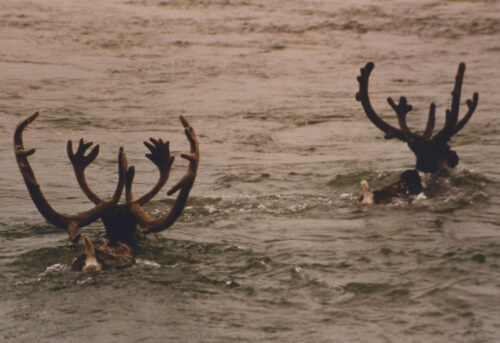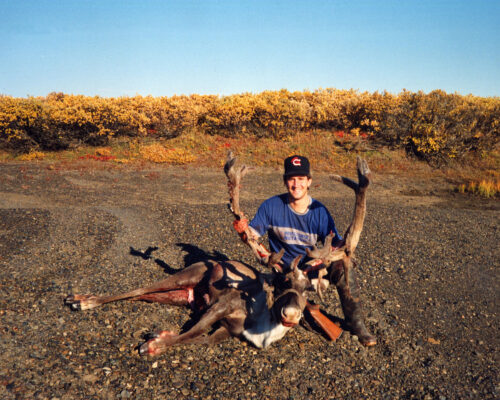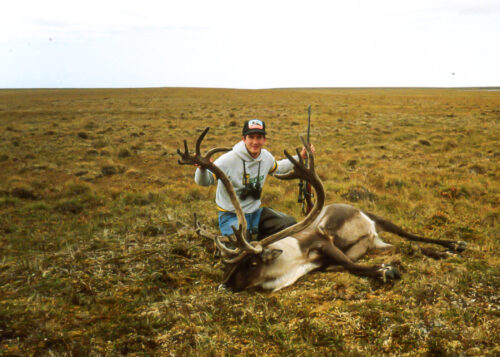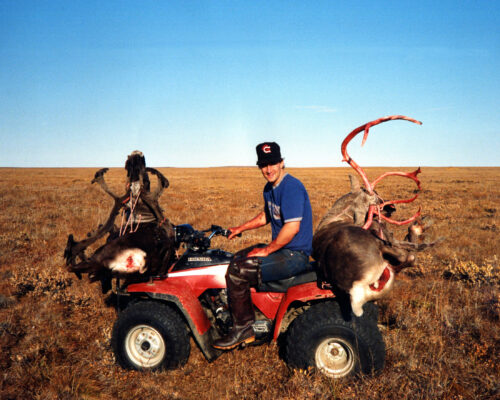
Right Among The Bulls: A Hunter Talks North Slope Caribou Memories
The following appears in the February issue of Alaska Sporting Journal:

BY SCOTT HAUGEN
Peeking over the willows lining the meandering creek, my breath was taken away at the sight of nearly 100 bull caribou fording the nearby Kokolik River.
The hollow hairs of the caribou caused their bodies to ride high in the water, exposing most of their backs. Their oversized hooves that serve them so well on soggy tundra, splayed out, and used as paddles, propelled the ungulates swiftly across the river.
Hauling their wet bodies out of the stream, the caribou shook their drenched coats and quickly made their way to a gravel bar lined with 7-foot-high willows. I stood only 150 yards away from the herd and noticed a commotion in the brush behind where the caribou stood. The dense grove of willows were dancing to a beat of their own.
The conditions were unseasonably warm and windless, a rarity in my years of fall hunting in the Arctic. The wind was not blowing hard enough to cause such a ruckus within the willows. Through my binoculars, I watched in consternation as dozens of sets of caribou antlers were scraped and thrashed against the willows as the animals tried to rid their headgear of the itching, drying velvet. With a bit of stealth, I figured I could get in the middle of the herd without being noticed.

ON THIS EARLY SEPTEMBER day I found myself on the tundra a few miles south of where my wife Tiffany and I lived at the time in Point Lay.
Point Lay was a tiny village of less than 100 residents when we lived there in the early 1990s. We carried out a semi-subsistence lifestyle, as the village had no regular store. All the meat we ate was what we hunted and fished for. Caribou were an integral part of our diet.
Here, there were no distant mountains, hills or even mounds of dirt to assist in navigation. Travel was achieved by referencing creeks, rivers, tundra and the vast Arctic Ocean.
Locating caribou on the flat tundra sounds like an easy task. Wide tracts of open terrain are optimal for spotting game, but when your backyard, the North Slope, has an area of 88,000 square miles, it can be nearly impossible to locate animals. The North Slope alone comprises 15 percent of Alaska’s total area, and finding any animals in such spacious land seems unfeasible. But on this day I was lucky.
Crouched at the edge of the creek bed, with only willows and flat ground separating me and the caribou, I thought carefully of what my next move would be. My adrenaline level shot up, sensing I was going to get into the willows and roam with the caribou.
I vowed not to look up again until I hit the junction where the creek joined the river. I dropped down into the bottom of the creek bed and after 125 yards of crawling through willows, I finally made it to the mouth of the stream.

BEFORE ME, HUNDREDS OF bull caribou milled around. I knew I could get closer, as they still hadn’t detected me. I broke out onto an open gravel bar pocked with clumps of willows. Sneaking closer to the herd, crawling from willow bush to willow bush to conceal my presence, I methodically narrowed the distance. After 50 yards of such antics, I reentered the thick willow grove and knew I had to be close to the middle of the herd.
I hunkered down and caught my breath before attempting to relocate the bulls through the willows that screened me. I didn’t need to look hard, as I could hear the caribou breathing heavily, their bony headgear slapping and scraping bark all around me.
Just 25 feet away a bull punished a willow bush. I could see flaps of velvet, glistening crimson as it peeled from the antlers and was flung over the tops of the caribou’s main beams.
From behind me, another bull ran by, its head down and rack free of velvet free. It inquisitively searched for a rival bull to challenge. The prerut was commencing. I maneuvered toward the river to see if any more caribou were crossing the stream. Just then a herd of a dozen bulls pulled themselves onto the gravel bar. Only a small patch of willows separated us.
As the animals shook in unison, the sunlight reflected off of the airborne mist to form a captivating rainbow. Most of the herd continued to the willows, but one big bull that had already shed its velvet lagged behind.
Suddenly, another bull bolted past me. It met the awaiting bull head-on at the river’s edge, where a fierce battle commenced. Fur and gravel flew as the mighty strength of the two bulls exploded in combat. I watched for nearly five minutes as the bulls fought less than 30 yards from me. I could literally feel the ground shake. At last, the subordinate bull tired and sauntered through the willows, bound for open tundra.
Slowly and quietly, I retreated into the willows. I continued watching bulls fight and rake the willows for over an hour, forgetting about the gun I toted. It was one of the most magical moments of my life.
Leisurely, as if by some innate command, most of the bulls began heading to open tundra to feed, many of them free of the irritating velvet tissues. I figured I had better take a bull now. It was prior to winter’s onset and we were in need of meat.

JUST AS I WAS ready to initiate a stalk on a small group of bulls thrashing about in the willows, I heard rocks clashing behind me. While glancing through the vertical brush, I could see a lone bull making its way up the river bank.
Walking over the round river rock of the gravel bar, the big bull was heading right towards me. I sat tight, holding the gun against my body. The bull continued my way, stopping to beat up a willow bush less than 20 feet away. As the white-maned bull worked its way around the clump of willows, I slipped to the backside of the bush that ensconced me.
The bull sauntered right past where I had just moved from. I crouched down and tried not to breathe too loudly but grew antsy as the big bull edged closer to me.
Once it cleared the curtain of willows, all I had to do was simply hold the barrel of my gun out, brace it against my hip and squeeze the trigger. The bull fell four steps from me.
The rest of the caribou continued feeding undisturbed on the tundra behind me, while others picked their way through the willows. As I field dressed my bull, two dozen sets of antlers skimmed the water’s surface as straggling bulls continued making their way across the river. I soaked in all I could, for it was a time I knew would not likely be replicated.
After field dressing the bull and getting it loaded onto the three-wheeler, I headed across the bumpy tundra and back to the village. That’s when another bachelor herd of caribou emerged from a creek carving its way through the tundra. Tiffany and I were in need of meat for winter and early fall caribou was our favorite. Plus, though I’d only been driving a short while, I knew having a bull on the front rack would help balance the loads.
I eased off the machine, walked a short distance and laid prone on the tundra. Resting the crosshairs behind the bull’s front shoulder, I fired. The bull lunged forward, turned a pirouette and dropped 75 yards from me.
Though not a record book head, the bull had exceptionally heavy antlers. Its high-reaching shovel and white mane made it a fine prize. This bull adorns my office wall, one that I look at every day, even as I write these words. It’s a vivid reminder of one of the most exciting hunts of my life.

THIS WAS CARIBOU HUNTING at its finest. Simply getting the opportunity to see hundreds of bulls ford the river, along with a couple hundred cows and calves grazing on the tundra, was enthralling. Observing their behaviors and interactions at such close range was a thrill that will be with me for eternity.
For a brief moment in time I walked with the caribou and was mesmerized by the presence of so many stunning bulls. On this day of collecting meat for the winter, I saw more than just caribou on the tundra. I saw what so many generations of subsistence hunters had seen before me. I saw a river of antlers. ASJ
Editor’s note: To order signed copies of Scott Haugen’s many popular fishing and hunting books, visit scotthaugen.com. Follow his adventures on Instagram and Facebook.



